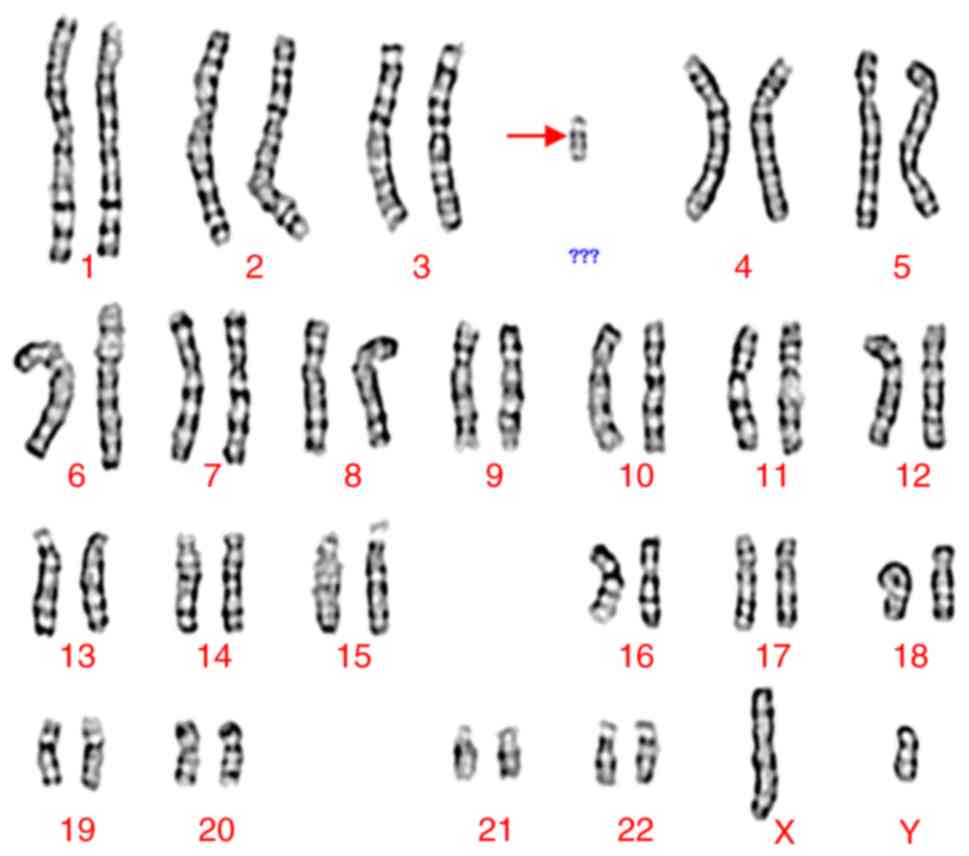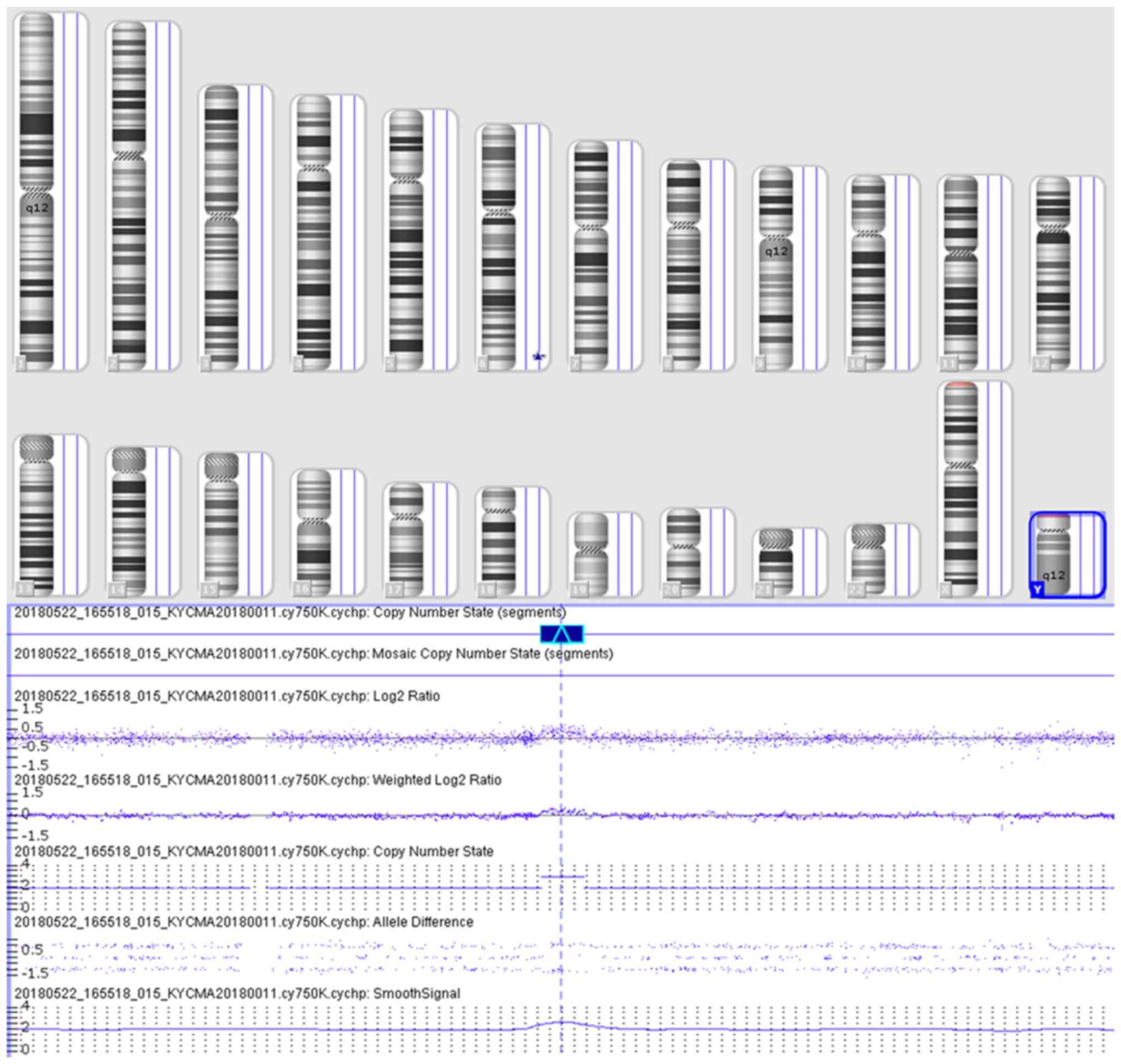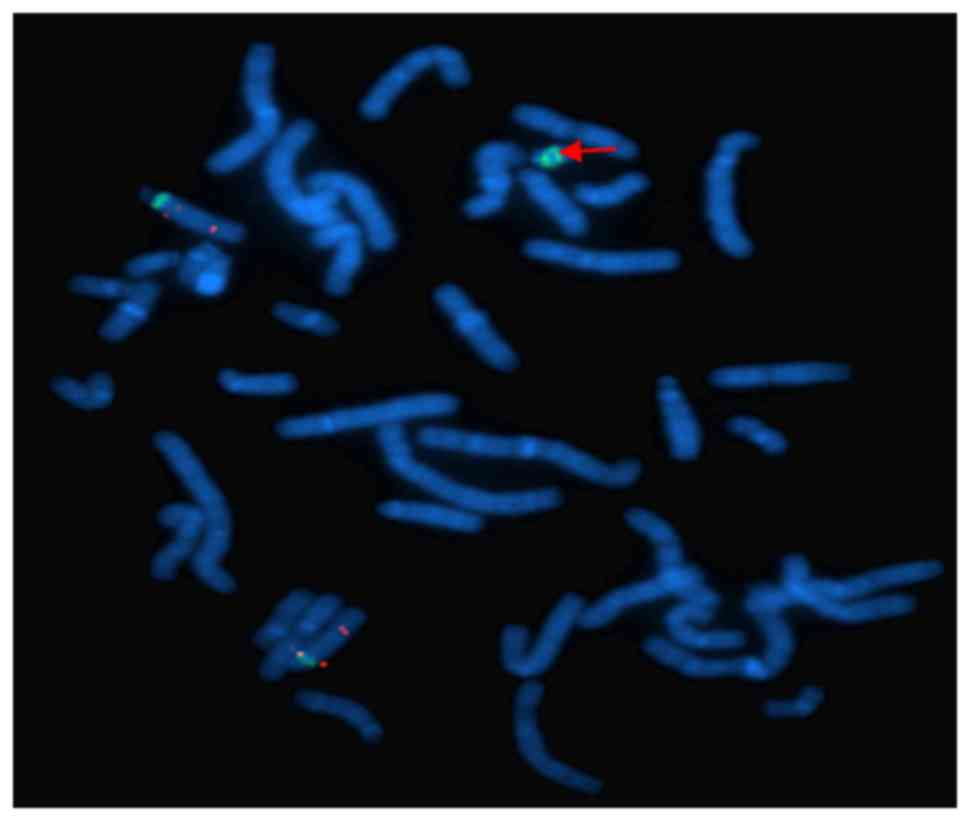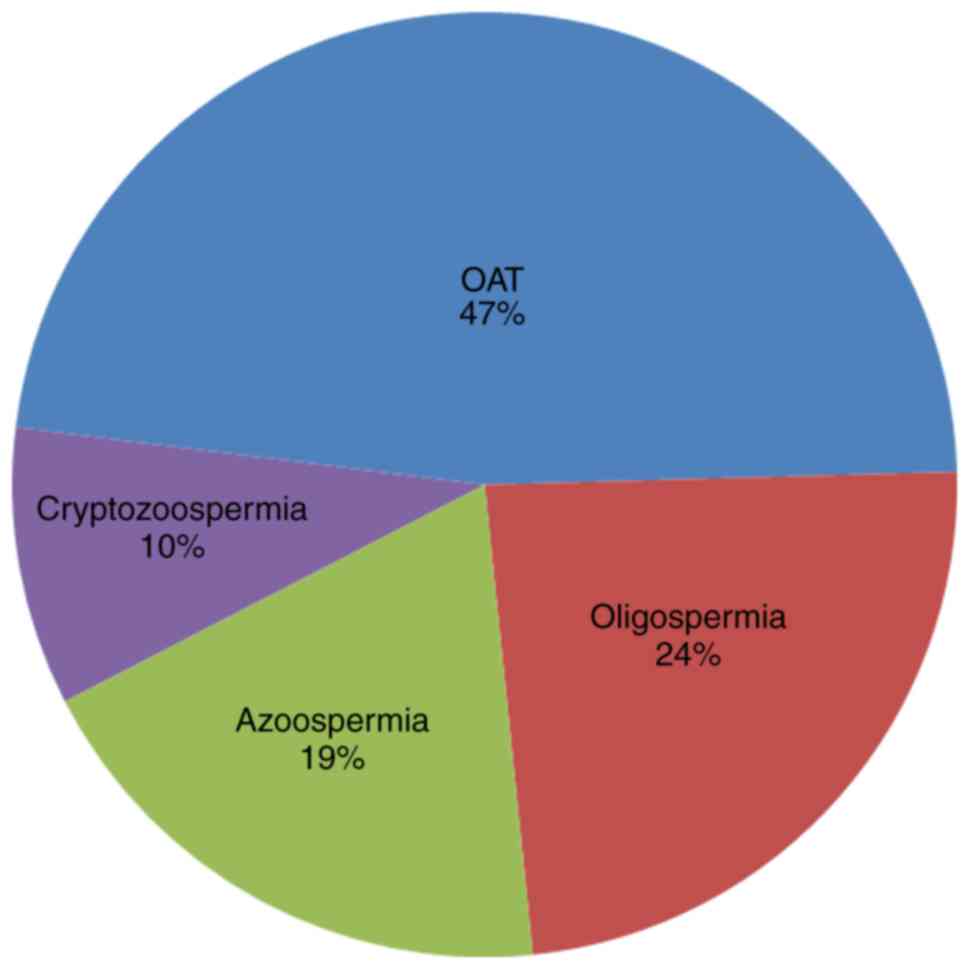|
1
|
Armanet N, Tosca L, Brisset S, Liehr T and
Tachdjian G: Small supernumerary marker chromosomes in human
infertility. Cytogenet Genome Res. 146:100–108. 2015.PubMed/NCBI View Article : Google Scholar
|
|
2
|
Neto FT, Bach PV, Najari BB, Li PS and
Goldstein M: Genetics of Male Infertility. Curr Urol Rep.
17(70)2016.PubMed/NCBI View Article : Google Scholar
|
|
3
|
Manvelyan M, Riegel M, Santos M, Fuster C,
Pellestor F, Mazaurik ML, Schulze B, Polityko A, Tittelbach H,
Reising-Ackermann G, et al: Thirty-two new cases with small
supernumerary marker chromosomes detected in connection with
fertility problems: Detailed molecular cytogenetic characterization
and review of the literature. Int J Mol Med. 21:705–714.
2008.PubMed/NCBI
|
|
4
|
Liehr T and Hamid Al-Rikabi AB: Impaired
spermatogenesis due to small supernumerary marker chromosomes: The
reason for infertility is only reliably ascertainable by
cytogenetics. Sex Dev. 2018.PubMed/NCBI View Article : Google Scholar : (Epub ahead of
print).
|
|
5
|
Wang H, Wang T, Yang N, He Y, Chen L, Hong
L, Shao X and Li H, Zhu H and Li H: The clinical analysis of small
supernumerary marker chromosomes in 17 children with mos
45,X/46,X,+mar karyotype. Oncol Lett. 13:4385–4389. 2017.PubMed/NCBI View Article : Google Scholar
|
|
6
|
Plaja A, Lloveras E, Martinez-Bouzas C,
Barreña B, Del Campo M, Fernández A, Herrero M, Barranco L, Palau
N, López-Aríztegui MA, et al: Trisomy 18p caused by a supernumerary
marker with a chromosome 13/21 centromere: A possible recurrent
chromosome aberration. Am J Med Genet A. 161A:2363–2368.
2013.PubMed/NCBI View Article : Google Scholar
|
|
7
|
Guediche N, Tosca L and Kara Terki A:
Array comparative genomic hybridization analysis of small
supernumerary marker chromosomes in human infertility. Reprod
Biomed Online. 24:72–82. 2012.PubMed/NCBI View Article : Google Scholar
|
|
8
|
Quinonez SC, Gelehrter TD and Uhlmann WR:
A Marfan syndrome-like phenotype caused by a neocentromeric
supernumerary ring chromosome 15. Am J Med Genet A. 173:268–273.
2017.PubMed/NCBI View Article : Google Scholar
|
|
9
|
Crolla JA, Youings SA, Ennis S and Jacobs
PA: Supernumerary marker chromosomes in man: Parental origin,
mosaicism and maternal age revisited. Eur J Hum Genet. 13:154–160.
2005.PubMed/NCBI View Article : Google Scholar
|
|
10
|
WHO Laboratory Manual for the Examination
and Processing of Human Semen. 5th edition. World Health
Organization, Geneva, 2010.
|
|
11
|
Zhang H, Wang R, Li L, Jiang Y, Zhang H
and Liu R: Clinical feature of infertile men carrying balanced
translocations involving chromosome 10: Case series and a review of
the literature. Medicine (Baltimore). 97(e0452)2018.PubMed/NCBI View Article : Google Scholar
|
|
12
|
McGowan-Jordan J, Simons A and Schmid M:
ISCN (2016): An International System for Human Cytogenetic
Nomenclature. Basel, Switzerland: Karger. 2016.
|
|
13
|
Hochstenbach R, Nowakowska B, Volleth M,
Ummels A, Kutkowska-Kaźmierczak A, Obersztyn E, Ziemkiewicz K,
Gerloff C, Schanze D, Zenker M, et al: Multiple small supernumerary
marker chromosomes resulting from maternal meiosis i or ii errors.
Mol Syndromol. 6:210–221. 2016.PubMed/NCBI View Article : Google Scholar
|
|
14
|
Sun M, Zhang H, Li G, Guy CJ, Wang X, Lu
X, Gong F, Lee J, Hassed S and Li S: Molecular characterization of
20 small supernumerary marker chromosome cases using array
comparative genomic hybridization and fluorescence in situ
hybridization. Sci Rep. 7(10395)2017.PubMed/NCBI View Article : Google Scholar
|
|
15
|
Peschka B, Leygraaf J, Van der Ven K,
Montag M, Schartmann B, Schubert R, van der Ven H and Schwanitz G:
Type and frequency of chromosome aberrations in 781 couples
undergoing intracytoplasmic sperm injection. Hum Reprod.
14:2257–2263. 1999.PubMed/NCBI View Article : Google Scholar
|
|
16
|
Cetin Z, Berker Karaüzüm S, Yakut S, Mihçi
E, Baumer A, Wey E, Taçoy S, Bağci G and Lüleci G: M-FISH
applications in clinical genetics. Genet Couns. 16:257–268.
2005.PubMed/NCBI
|
|
17
|
Liehr T: Small supernumerary marker
chromosomes detected in connection with infertility. Zhonghua Nan
Ke Xue. 20:771–780. 2014.PubMed/NCBI
|
|
18
|
Paetzold U, Schwanitz G, Schubert R, van
der Ven K and Montag M: Sperm analyses, genetic counseling and
therapy in an infertile carrier of a supernumerary marker
chromosome 15. Adv Med Sci. 51:31–35. 2006.PubMed/NCBI
|
|
19
|
Vulcani-Freitas TM, Gil-da-Silva-Lopes VL,
Varella-Garcia M and Maciel-Guerra AT: Infertility and marker
chromosomes: Application of molecular cytogenetic techniques in a
case of inv dup(15). J Appl Genet. 47:89–91. 2006.PubMed/NCBI View Article : Google Scholar
|
|
20
|
Magdi Y, Darwish E, Elbashir S, Majzoub A
and Agarwal A: Effect of modifiable lifestyle factors and
antioxidant treatment on semen parameters of men with severe
oligoasthenoteratozoospermia. Andrologia: Nov 10, 2017 (Epub ahead
of print). doi: 10.1111/and.12694.
|
|
21
|
Liehr T and Weise A: Frequency of small
supernumerary marker chromosomes in prenatal, newborn,
developmentally retarded and infertility diagnostics. Int J Mol
Med. 19:719–731. 2007.PubMed/NCBI
|
|
22
|
Liehr T and Kosyakova N: Small
supernumerary marker chromosomes (sSMC)-what about the
genotype-phenotype correlation? Tsitologiia. 55:165–166.
2013.PubMed/NCBI
|
|
23
|
Battaglia A: The inv dup (15) or idic (15)
syndrome (Tetrasomy 15q). Orphanet J Rare Dis. 3(30)2008.PubMed/NCBI View Article : Google Scholar
|
|
24
|
Cotter PD, Ko E, Larabell SK, Rademaker AW
and Martin RH: Segregation of a supernumerary del(15) marker
chromosome in sperm. Clin Genet. 58:488–492. 2000.PubMed/NCBI View Article : Google Scholar
|
|
25
|
Koç A, Onur SO, Ergün MA and Perçin EF:
Supernumerary marker chromosome 15 in a male with azoospermia and
open bite deformity. Asian J Androl. 11:617–622. 2009.PubMed/NCBI View Article : Google Scholar
|
|
26
|
Liehr T: Small supernumerary marker
chromosomes-an update. Mol Cytogenet: Jan 21, 2014 (Epub ahead of
print). doi: 10.1186/1755-8166-7-S1-I11.
|
|
27
|
Clarke R, Peden JF, Hopewell JC, Kyriakou
T, Goel A, Heath SC, Parish S, Barlera S, Franzosi MG, Rust S, et
al: Genetic variants associated with Lp(a) lipoprotein level and
coronary disease. New Eng J Med. 361:2518–2528. 2009.PubMed/NCBI View Article : Google Scholar
|
|
28
|
Gründemann D, Gorboulev V, Gambaryan S,
Veyhl M and Koepsell H: Drug excretion mediated by a new prototype
of polyspecific transporter. Nature. 372:549–552. 1994.PubMed/NCBI View
Article : Google Scholar
|
|
29
|
Hoermann S, Gai Z, Kullak-Ublick GA and
Visentin M: Plasma membrane cholesterol regulates the allosteric
binding of 1-methyl-4-phenylpyridinium to organic cation
transporter 2 (SLC22A2). J Pharmacol Exp Ther. 372:46–53.
2020.PubMed/NCBI View Article : Google Scholar
|
|
30
|
Gründemann D, Schechinger B, Rappold GA
and Schömig E: Molecular identification of the
corticosterone-sensitive extraneuronal catecholamine transporter.
Nat Neurosci. 1:349–351. 1998.PubMed/NCBI View
Article : Google Scholar
|
|
31
|
Wu X, Huang W, Ganapathy ME, Wang H,
Kekuda R, Conway SJ, Leibach FH and Ganapathy V: Structure,
function, and regional distribution of the organic cation
transporter OCT3 in the kidney. Am J Physiol Renal Physiol.
279:F449–F458. 2000.PubMed/NCBI View Article : Google Scholar
|
|
32
|
Mangan H, Gailín MÓ and McStay B:
Integrating the genomic architecture of human nucleolar organizer
regions with the biophysical properties of nucleoli. FEBS J.
284:3977–3985. 2017.PubMed/NCBI View Article : Google Scholar
|
|
33
|
Martín-Lucas MA, Pérez-Castillo A and
Abrisqueta JA: Infertility associated with two accessory
bisatellited chromosomes. Hum Genet. 73:133–136. 1986.PubMed/NCBI View Article : Google Scholar
|
|
34
|
Gentile M, Susca F, Resta N, Stella A,
Cascone A and Guanti G: Infertility in carriers of two bisatellited
marker chromosomes. Clin Genet. 44:71–75. 1993.PubMed/NCBI View Article : Google Scholar
|
|
35
|
Kirkpatrick G, Ren H, Liehr T, Chow V and
Ma S: Meiotic and sperm aneuploidy studies in three carriers of
Robertsonian translocations and small supernumerary marker
chromosomes. Fertil Steril. 103:1162–1169e7. 2015.PubMed/NCBI View Article : Google Scholar
|
|
36
|
Perrin A, Nguyen MH, Delobel B, Guéganic
N, Basinko A, Le Bris MJ, Douet-Guilbert N, De Braekeleer M and
Morel F: Characterization and meiotic segregation of a
supernumerary marker chromosome in sperm of infertile males: Case
report and literature review. Eur J Med Genet. 55:743–746.
2012.PubMed/NCBI View Article : Google Scholar
|
|
37
|
Oracova E, Musilova P, Kopecna O, Rybar R,
Vozdova M, Vesela K and Rubes J: Sperm and embryo analysis in a
carrier of supernumerary inv dup(15) marker chromosome. J Androl.
30:233–239. 2009.PubMed/NCBI View Article : Google Scholar
|
|
38
|
Ranisch R: Germline genome editing versus
preimplantation genetic diagnosis: Is there a case in favour of
germline interventions? Bioethics. 34:60–69. 2020.PubMed/NCBI View Article : Google Scholar
|


















